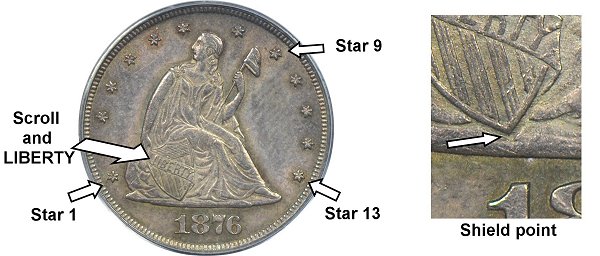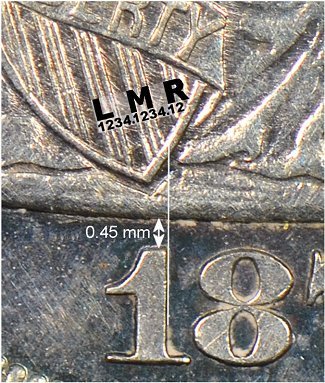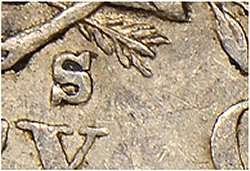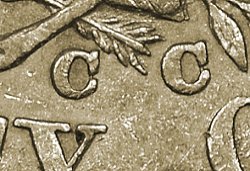6.1 Terminology and Abbreviations
Obverse
The obverse features a seated figure of Liberty, holding a pole with a liberty cap at the top. Liberty is seated on a rock and holding a shield with LIBERTY inscribed along a
diagonal ribbon or scroll. The letters of LIBERTY are raised unlike the other Liberty Seated coinage where the letters are incuse. There are 13 stars surrounding the figure,
representing the 13 original states.
The following terms are used in referring to the obverse (and denoted on the photos below):
- Star 1 to star 13: the number of the star, beginning with the lower left (star 1), proceeding clock-wise around the coin to the lower right (star 13).
- Liberty: the seated figure of Liberty
- LIBERTY: the word “LIBERTY” that adorns the shield
- Scroll: the ribbon where the word “LIBERTY” is found
- Shield point: the lower tip of the shield that may be used to line up with the date to determine die identity through date position

Date Position Classification
|
When identifying obverse dies, one of the key factors will be the position of the date. This requires the position both from the horizontal and vertical perspectives. One important and
easy-to-see characteristic is whether the date is left or right, and can often be easily identified by looking at how the right side of the 1 in the date lines up with the shield point.
By extending the right side of the 1 upward, one can see how it lines up.
|
 Date right of shield point |
The greatest number of obverse dies were used when striking the 1875-S coins. As such, there are a number of date positions that are fairly similar and a more precise method is needed to identify
one obverse from another. To assist in this situation, each date position is measured from left-to-right using the lines of three of the stripes within the shield, and top-to-bottom by measuring
the separation between the base of the rock and the top of the 1 in the date, measured in millimeters.
Using the picture below to illustrate, the three stripes are designated L (left), M (middle), and R (right). The individual lines that make up each stripe are designated:
1, 2, and 3. The gap between the stripe and the stripe to its right is 1½ lines wide, and this space is designated with by virtual lines: 4, and 4½ (represented by a “.” in the picture below).
For example, the third bar in the left stripe is designated L 3.
 |
In the example to the left, the date position is given the designation: |
Reverse
The reverse features an eagle, clutching an olive branch (symbolizing peace) in one claw, and three arrows (symbolizing strength and readiness for conflict) in the other. The legend
UNITED STATES OF AMERICA surrounds the eagle, and the denomination TWENTY CENTS lies beneath it.
The mintmark, if any (either S or CC) lies beneath the stem of the olive branch, the arrow’s feather end, and the eagle’s left (viewer’s right) claw. All of the S and CC mintmarks
within the twenty-cent series are from the same size punch (0.8 mm) and have no variation in size.
 |
 |
The following are used when referring to the reverse (and denoted on the photo below):
- The three sets of olive leaves on the branch are designated left, middle, and right.
- The legend represents the words, UNITED STATES OF AMERICA.
Edge
The twenty-cent piece has a plain edge, without reeding or lettering.
Scarcity, Rarity Ratings, and Pricing
The following descriptions are offered for the estimates of scarcity for each die marriage. They follow both the commonly-used Sheldon rarity ratings scale, as well as the description
provided for each, which are commonly found in many numismatic reference books.
Rarity Rating |
Estimated # of known examples |
Description |
| R-1 | 1250+ | Common die marriage |
| R-2 | 501-1250 | Slightly better die marriage |
| R-3 | 201-500 | Available, but will require some searching |
| R-4 | 76-200 | Scarce – may or may not find at a large show or auction |
| R-5 | 31-75 | Very scarce – only a few are offered each year |
| R-6 | 13-30 | Extremely scarce – only 1 or perhaps 2 offered in a year’s time |
| R-7 | 4-12 | Rare – almost never seen, offered for sale every few years |
| R-8 | 1-3 | Unique, or nearly so |
Each die marriage listed in this book is assigned one of the above rarity ratings.
The authors have deliberately not attempted to assign a monetary value to either a specific date, or a particular die marriage. This is for two primary reasons. First, the value of coins is
volatile and can change dramatically based on market conditions. As a result, any prices given in this book would be obsolete at the time of printing. Second, the rarity of a particular
die marriage may not correspond directly to its market value. The value of a variety is significantly influenced by collector demand and thus if a rare variety has little demand, the price may be
lower than for a more common coin for which many collectors are searching.
6.2 Detailed Analysis
What follows is a detailed examination of each date and mintmark in the series, including specific details on each known die marriage. The reader should understand that as
he or she examines coins, they may or may not show all of the diagnostics covered here. Some characteristics such as die cracks and damage occur over the life of a given die, and thus coins
struck during earlier die states may not exhibit all of the attributes present in a later die states. Also, lower grade coins may have had those details worn away. However, it is hoped that
enough information is presented to allow the reader to attribute the coins they are examining.
Inspired by Gerry Fortin’s and Bill Bugert’s novel approach in their references, some of the die descriptions are accompanied by enhanced die crack drawings that illustrate the extent of die cracks
known on the selected dies. These drawings are meant to aid in rapid identification of the specific dies and specific die states. It should be noted that due to the more numerous and complex
devices in the reverse design of the twenty-cent piece, the reverse dies tend to develop die cracks much more frequently than the obverse dies.
